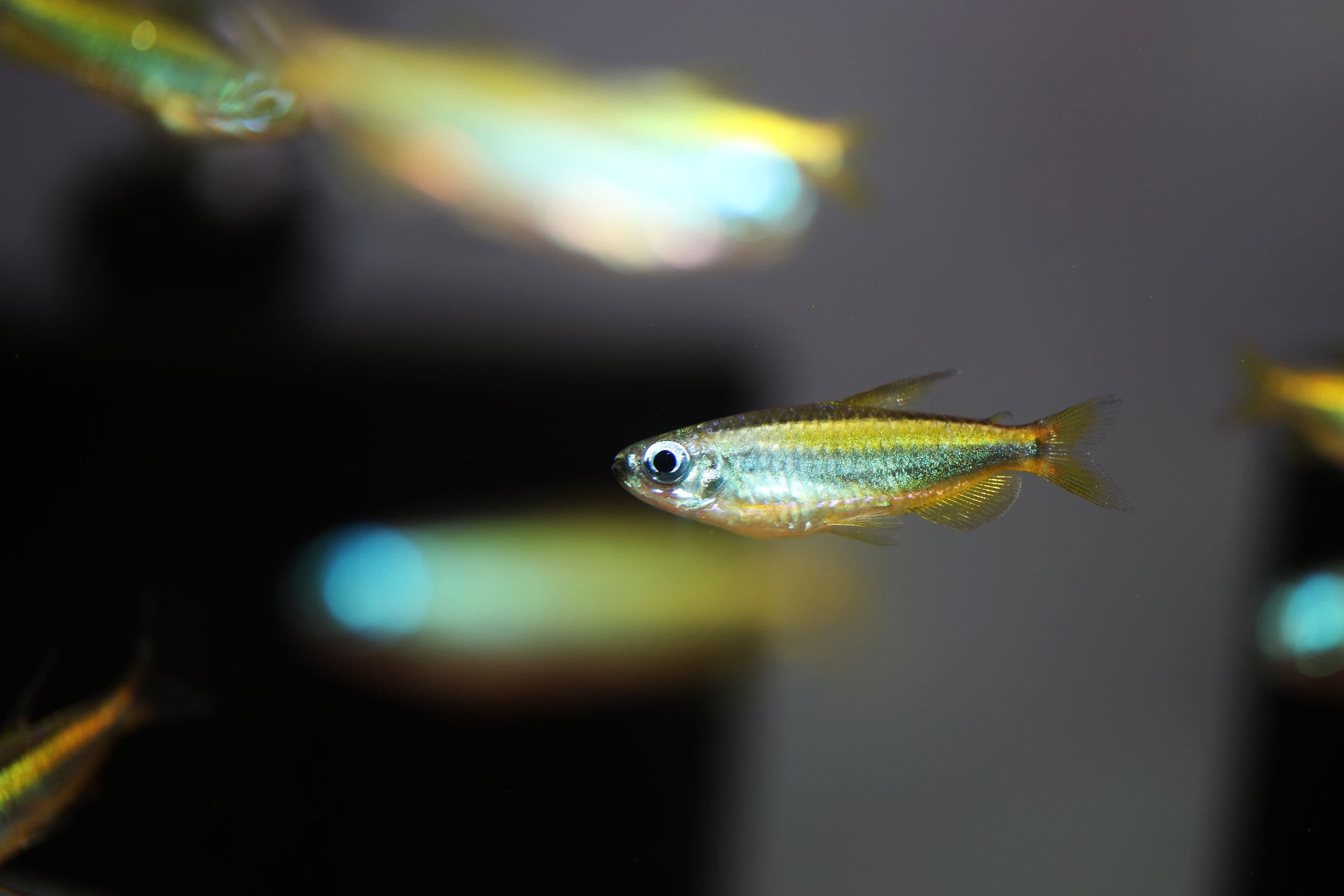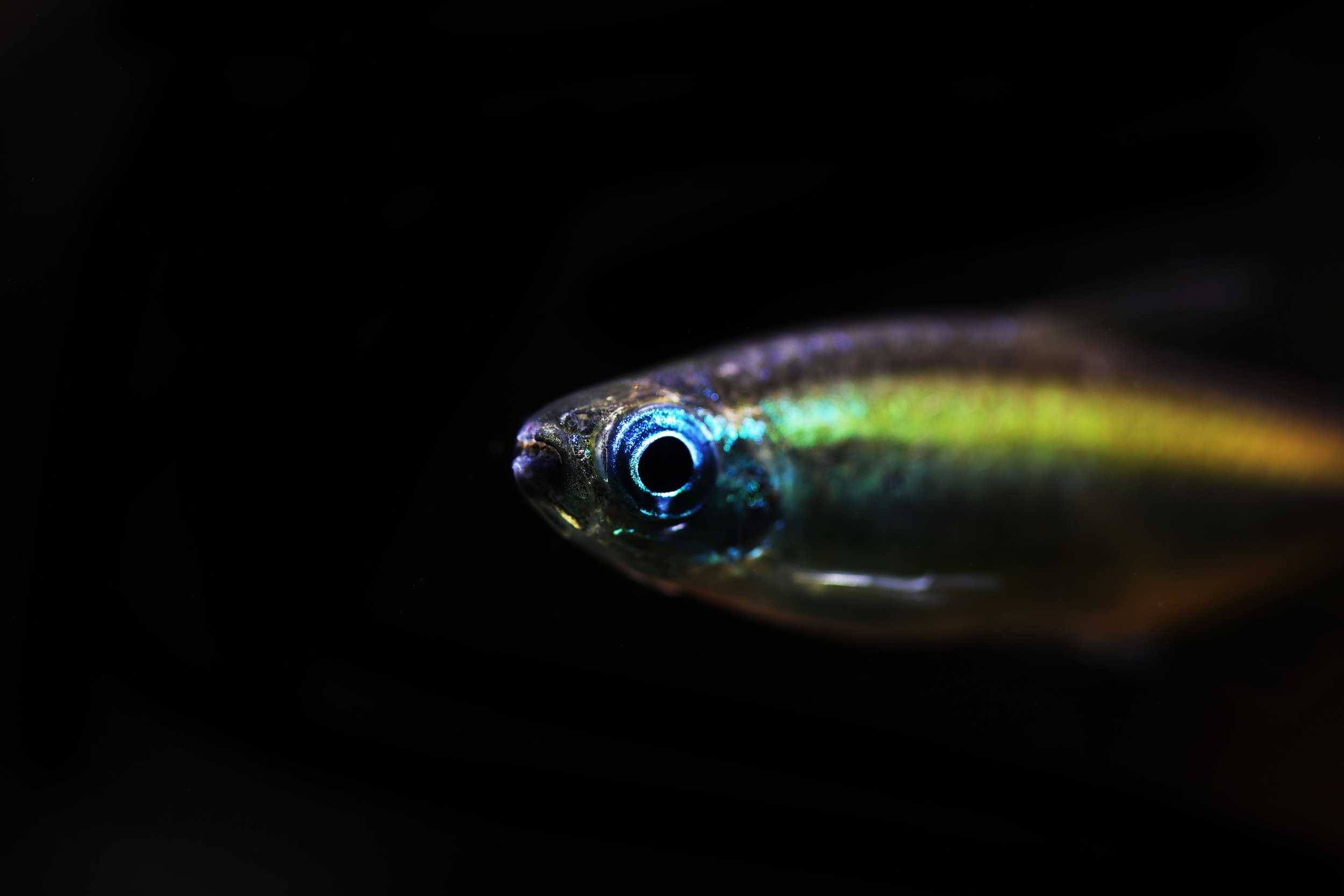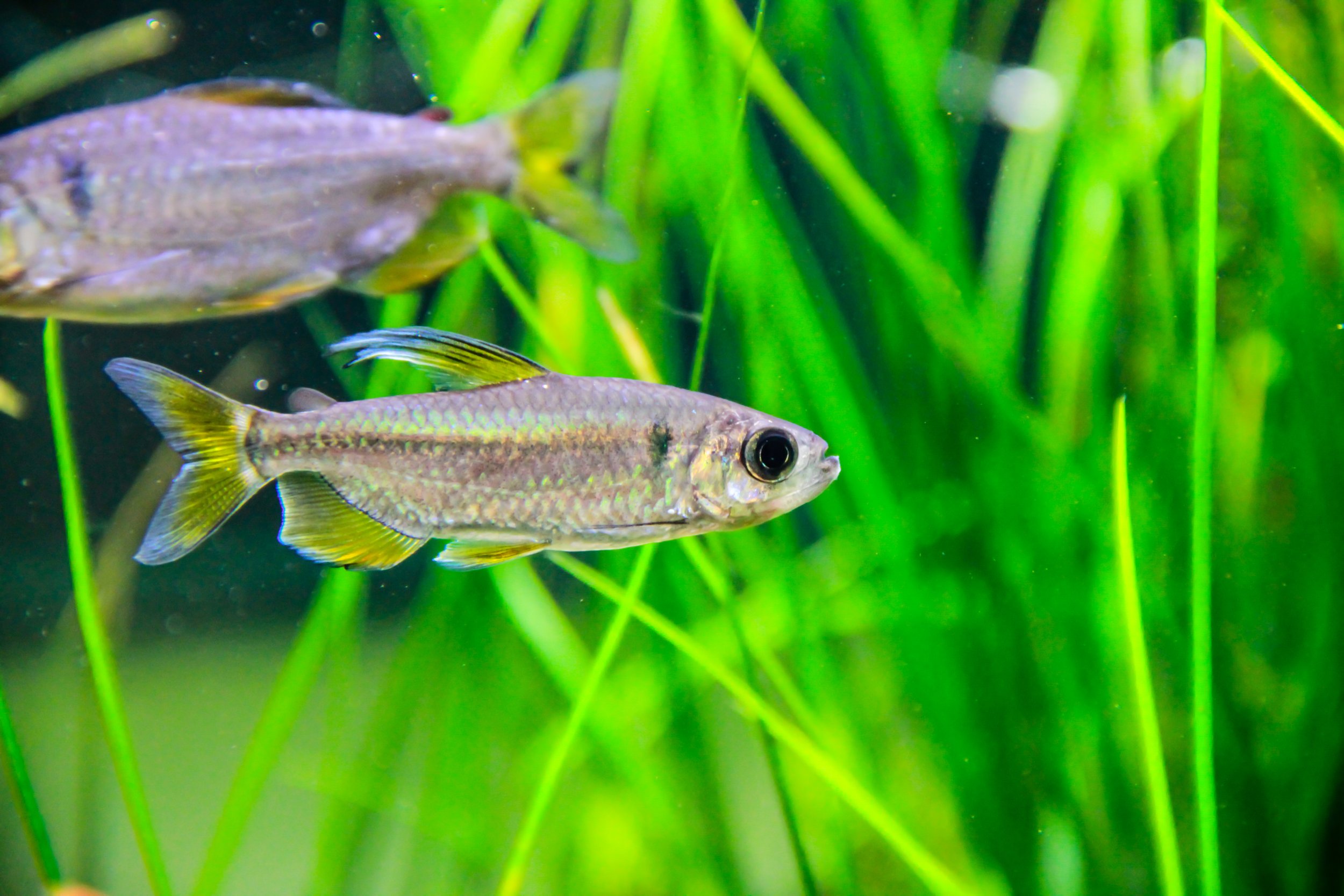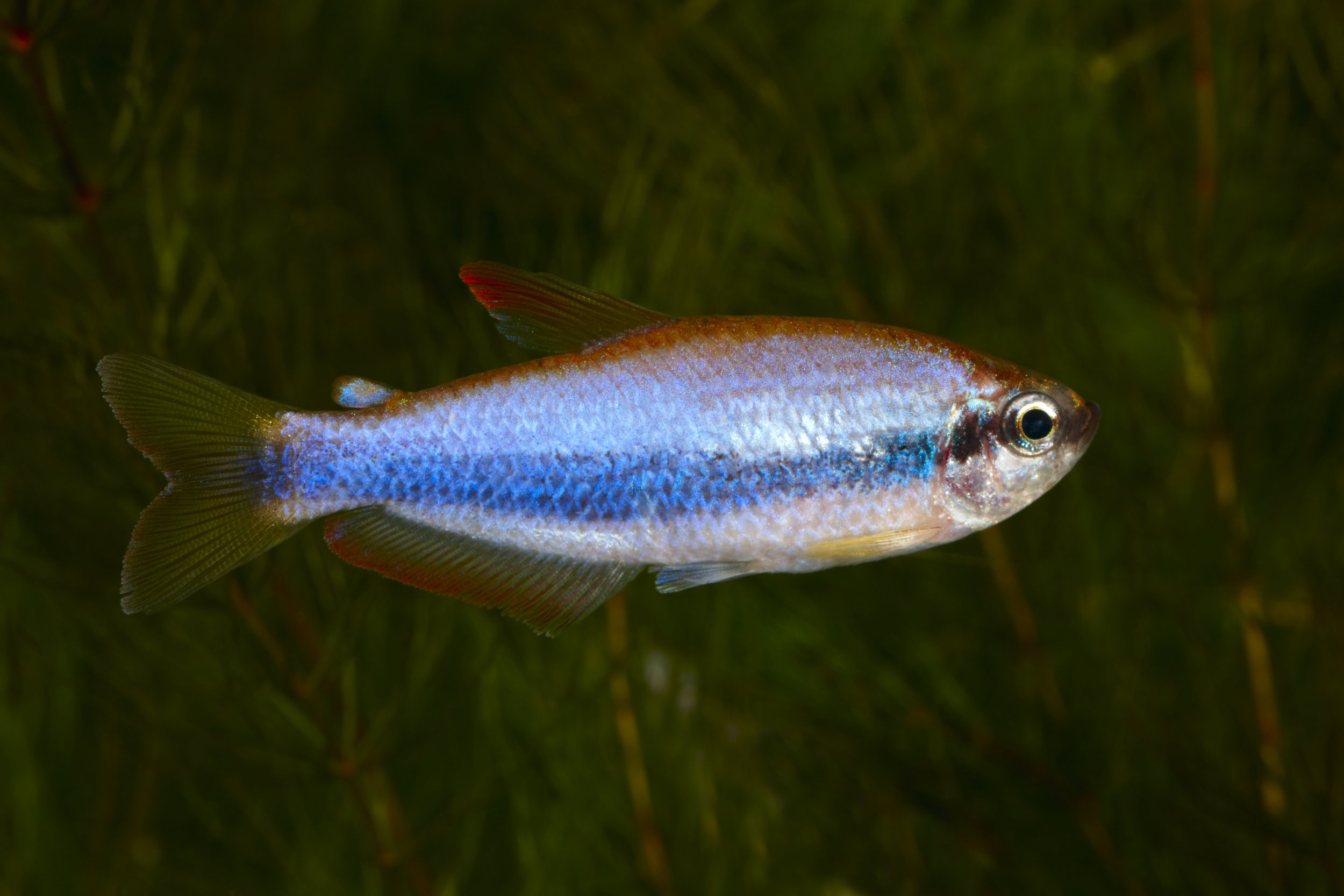 Image 1 of 2
Image 1 of 2

 Image 2 of 2
Image 2 of 2



Blue-Eyed Congo Tetra WILD-M
The Blue-Eyed Congo Tetra, scientifically known as Phenacogrammus aurantiacus, is a rare and stunning freshwater fish native to the Congo River Basin in Central Africa. Known for its metallic body and striking blue eyes, this species is a captivating choice for aquarists looking to add an exotic and unique centerpiece to their aquarium.
Physically, the Blue-Eyed Congo Tetra features an elongated, slender body with a radiant metallic sheen that reflects shades of gold, silver, or bronze under aquarium lighting. Its vivid blue eyes provide a striking contrast to its shimmering body, making it an eye-catching addition to any tank. Adults typically grow to about 2.5 to 3 inches (6 to 7.5 centimeters) in length, making them a manageable size for medium to large aquariums.
In the aquarium, Blue-Eyed Congo Tetras thrive in groups of six or more, as their schooling behavior promotes natural activity and reduces stress. A tank of at least 30 gallons is recommended for a small group, with larger tanks offering more space for dynamic swimming and interaction. Their environment should include a soft, sandy substrate, plenty of open swimming areas, and plants or driftwood to provide cover and mimic their natural habitat.
Water parameters for Blue-Eyed Congo Tetras should replicate their native conditions. They prefer slightly acidic to neutral water with a pH range of 6.0 to 7.5 and temperatures between 75 to 82°F (24 to 28°C). Regular water changes and efficient filtration are essential to maintain clean, well-oxygenated water, as they are sensitive to poor water quality.
Feeding Blue-Eyed Congo Tetras is straightforward, as they are omnivorous and will accept a variety of foods. A diet of high-quality flakes or micro-pellets should be supplemented with live or frozen foods such as brine shrimp, bloodworms, and daphnia to enhance their coloration and health. Occasional feedings of vegetable matter, such as spirulina-based foods or blanched spinach, are also beneficial.
Blue-Eyed Congo Tetras are peaceful and make excellent tank mates for other similarly sized, non-aggressive species. They pair well with other tetras, rasboras, Corydoras, and peaceful dwarf cichlids. Avoid housing them with large or aggressive species that may intimidate or outcompete them.
Breeding Blue-Eyed Congo Tetras in captivity is possible but challenging, as they require specific conditions to stimulate spawning. They are egg scatterers, and providing a separate breeding tank with soft, slightly acidic water, fine-leaved plants, or spawning mops increases the likelihood of success. After spawning, the adults should be removed to prevent them from eating the eggs. The eggs hatch within 24 to 36 hours, and the fry become free-swimming in about a week. Fry can be fed infusoria or finely powdered fry food, transitioning to baby brine shrimp as they grow.
Overall, the Blue-Eyed Congo Tetra (Phenacogrammus aurantiacus) is a rare and visually stunning species that brings elegance and activity to freshwater aquariums. Their unique appearance, peaceful temperament, and schooling behavior make them a prized addition for aquarists seeking something truly special.
The Blue-Eyed Congo Tetra, scientifically known as Phenacogrammus aurantiacus, is a rare and stunning freshwater fish native to the Congo River Basin in Central Africa. Known for its metallic body and striking blue eyes, this species is a captivating choice for aquarists looking to add an exotic and unique centerpiece to their aquarium.
Physically, the Blue-Eyed Congo Tetra features an elongated, slender body with a radiant metallic sheen that reflects shades of gold, silver, or bronze under aquarium lighting. Its vivid blue eyes provide a striking contrast to its shimmering body, making it an eye-catching addition to any tank. Adults typically grow to about 2.5 to 3 inches (6 to 7.5 centimeters) in length, making them a manageable size for medium to large aquariums.
In the aquarium, Blue-Eyed Congo Tetras thrive in groups of six or more, as their schooling behavior promotes natural activity and reduces stress. A tank of at least 30 gallons is recommended for a small group, with larger tanks offering more space for dynamic swimming and interaction. Their environment should include a soft, sandy substrate, plenty of open swimming areas, and plants or driftwood to provide cover and mimic their natural habitat.
Water parameters for Blue-Eyed Congo Tetras should replicate their native conditions. They prefer slightly acidic to neutral water with a pH range of 6.0 to 7.5 and temperatures between 75 to 82°F (24 to 28°C). Regular water changes and efficient filtration are essential to maintain clean, well-oxygenated water, as they are sensitive to poor water quality.
Feeding Blue-Eyed Congo Tetras is straightforward, as they are omnivorous and will accept a variety of foods. A diet of high-quality flakes or micro-pellets should be supplemented with live or frozen foods such as brine shrimp, bloodworms, and daphnia to enhance their coloration and health. Occasional feedings of vegetable matter, such as spirulina-based foods or blanched spinach, are also beneficial.
Blue-Eyed Congo Tetras are peaceful and make excellent tank mates for other similarly sized, non-aggressive species. They pair well with other tetras, rasboras, Corydoras, and peaceful dwarf cichlids. Avoid housing them with large or aggressive species that may intimidate or outcompete them.
Breeding Blue-Eyed Congo Tetras in captivity is possible but challenging, as they require specific conditions to stimulate spawning. They are egg scatterers, and providing a separate breeding tank with soft, slightly acidic water, fine-leaved plants, or spawning mops increases the likelihood of success. After spawning, the adults should be removed to prevent them from eating the eggs. The eggs hatch within 24 to 36 hours, and the fry become free-swimming in about a week. Fry can be fed infusoria or finely powdered fry food, transitioning to baby brine shrimp as they grow.
Overall, the Blue-Eyed Congo Tetra (Phenacogrammus aurantiacus) is a rare and visually stunning species that brings elegance and activity to freshwater aquariums. Their unique appearance, peaceful temperament, and schooling behavior make them a prized addition for aquarists seeking something truly special.
The Blue-Eyed Congo Tetra, scientifically known as Phenacogrammus aurantiacus, is a rare and stunning freshwater fish native to the Congo River Basin in Central Africa. Known for its metallic body and striking blue eyes, this species is a captivating choice for aquarists looking to add an exotic and unique centerpiece to their aquarium.
Physically, the Blue-Eyed Congo Tetra features an elongated, slender body with a radiant metallic sheen that reflects shades of gold, silver, or bronze under aquarium lighting. Its vivid blue eyes provide a striking contrast to its shimmering body, making it an eye-catching addition to any tank. Adults typically grow to about 2.5 to 3 inches (6 to 7.5 centimeters) in length, making them a manageable size for medium to large aquariums.
In the aquarium, Blue-Eyed Congo Tetras thrive in groups of six or more, as their schooling behavior promotes natural activity and reduces stress. A tank of at least 30 gallons is recommended for a small group, with larger tanks offering more space for dynamic swimming and interaction. Their environment should include a soft, sandy substrate, plenty of open swimming areas, and plants or driftwood to provide cover and mimic their natural habitat.
Water parameters for Blue-Eyed Congo Tetras should replicate their native conditions. They prefer slightly acidic to neutral water with a pH range of 6.0 to 7.5 and temperatures between 75 to 82°F (24 to 28°C). Regular water changes and efficient filtration are essential to maintain clean, well-oxygenated water, as they are sensitive to poor water quality.
Feeding Blue-Eyed Congo Tetras is straightforward, as they are omnivorous and will accept a variety of foods. A diet of high-quality flakes or micro-pellets should be supplemented with live or frozen foods such as brine shrimp, bloodworms, and daphnia to enhance their coloration and health. Occasional feedings of vegetable matter, such as spirulina-based foods or blanched spinach, are also beneficial.
Blue-Eyed Congo Tetras are peaceful and make excellent tank mates for other similarly sized, non-aggressive species. They pair well with other tetras, rasboras, Corydoras, and peaceful dwarf cichlids. Avoid housing them with large or aggressive species that may intimidate or outcompete them.
Breeding Blue-Eyed Congo Tetras in captivity is possible but challenging, as they require specific conditions to stimulate spawning. They are egg scatterers, and providing a separate breeding tank with soft, slightly acidic water, fine-leaved plants, or spawning mops increases the likelihood of success. After spawning, the adults should be removed to prevent them from eating the eggs. The eggs hatch within 24 to 36 hours, and the fry become free-swimming in about a week. Fry can be fed infusoria or finely powdered fry food, transitioning to baby brine shrimp as they grow.
Overall, the Blue-Eyed Congo Tetra (Phenacogrammus aurantiacus) is a rare and visually stunning species that brings elegance and activity to freshwater aquariums. Their unique appearance, peaceful temperament, and schooling behavior make them a prized addition for aquarists seeking something truly special.





